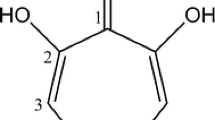Abstract
Cell-free supernatant from Shewanella oneidensis MR-1 reduced carbon tetrachloride to chloroform, a suspension of Fe(III) and solid Fe(III) to iron (II). The putative reducing agent was tentatively identified as menaquinone-1 (MQ-1)—a water-soluble menaquinone with a single isoprenoid residue in the side chain. Synthetic MQ-1 reduced carbon tetrachloride to chloroform and amorphous iron (III) hydroxide to iron (II). To test the generality of this result among menaquinones, the reductive activities of vitamin K2 (MQ-7)—a lipid-associated menaquinone with 7 or 8 isoprenoid residues—was evaluated. This molecule also reduced carbon tetrachloride to chloroform and iron (III) to iron (II). The results indicate that molecules within the menaquinone family may contribute to both the extracellular and cell-associated reduction of carbon tetrachloride and iron (III).




Similar content being viewed by others
References
Baeseman JL, Novak PJ (2001) Effects of various environmental conditions on the transformation of chlorinated solvents by Methanosarcina thermophila. Biotechnol Bioeng 75:634–641. doi:10.1002/bit.10029
Beliaev AS, Saffarini DA, McLaughlin JL, Hunnicutt D (2001) MtrC, an outer membrane decaheme c cytochrome required for metal reduction in Shewanella putrefaciens MR-1. Mol Microbiol 39:722–730. doi:10.1046/j.1365-2958.2001.02257.x
Bentley R, Meganathan R (1982) Biosynthesis of vitamin K (menaquinone) in bacteria. Microbiol Rev 46:241–280
Collins MD (1985) Analysis of isoprenoid quinones. Methods Microbiol 18:329–366
Criddle CS, McCarty PL (1991) Electrolytic model system for reductive dehalogenation in aqueous environments. Environ Sci Technol 25:973–978. doi:10.1021/es00017a022
Criddle CS, DeWitt JT, McCarty PL (1990a) Reductive dehalogenation of carbon tetrachloride by Escherichia coli k-12. Appl Environ Microbiol 56:3247–3254
Criddle CS, Dewitt JT, Grbic-Galic D, McCarty PL (1990b) Transformation of carbon tetrachloride by Pseudomonas sp. Strain KC under denitrification conditions. Appl Environ Microbiol 56:3240–3324
Curtis GP, Reinhard M (1994) Reductive dehalogenation of hexachloethane, carbon tetrachloride, and bromoform by anthrahydroquione disulfonate and humic acid. Environ Sci Technol 28:2393–2401. doi:10.1021/es00062a026
Dohnalkova A, Kennedy D, Marshall M, Gorby Y, Elias D, Fredrickson J (2005) Imaging and analysis of biominerals and nanostructures associated with bacterial membranes. Geochim Cosmochim Acta 69(Suppl. S):A673–A673
Dybas M, Tatara G, Criddle CS (1995) Localization and characterization of the carbon tetrachloride transformation activity of Pseudomonas sp. strain KC. Appl Environ Microbiol 61:758–762
Fieser LF, Campbell WP, Fry EM, Gates MD (1939) Naphthoquinones of the vitamin K1 type of structure. J Am Chem Soc 61:3216–3223. doi:10.1021/ja01266a068
Gorby Y, Biju V, Pan D, McLean J, Saffarini D, Fredrickson J et al (2005) Display and retraction of outer membrane cytochromes by Shewanella oneidensis in response to electron availability. Geochim Cosmochim Acta 69(Suppl. S):A671–A671
Koons BW, Baeseman JL, Novak PJ (2001) Investigation of cell exudates active in carbon tetrachloride and chloroform degradation. Biotechnol Bioeng 74:12–17. doi:10.1002/bit.1090
Lee CH, Lewis TA, Paszczynski A, Crawford RL (1999) Identification of an extracellular catalyst of carbon tetrachloride dehalogenation from Pseudomonas stutzeri strain KC as pyridine-2, 2-bis(thiocarboxylate). Biochem Biophys Res Commun 265:770–770. doi:10.1006/bbrc.1999.1741
Lovley DR, Holmes ED, Nevin KP (2004) Dissimilatory Fe(III) and Mn(IV) reduction. Adv Microb Physiol 49:219–286. doi:10.1016/S0065-2911(04)49005-5
Maier TM, Myers CR (2004) The outer membrane protein Omp35 affects the reduction of Fe(III), nitrate, and fumarate by Shewanella oneidensis MR-1. BMC Microbiol Art. No. 23 Jun 22
McCormick ML, Adriaens P (2004) Carbon tetrachloride transformation on the surface of nanoscale biogenic magnetite particles. Environ Sci Technol 38:1045–1053. doi:10.1021/es030487m
Myers CR, Myers JM (2002) MtrB Is Required for proper incorporation of the cytochromes OmcA and OmcB into the outer membrane of Shewanella putrefaciens MR-1. Appl Environ Microbiol 68:5585–5594. doi:10.1128/AEM.68.6.2781-2793.2002
Nealson KH, Saffarini D (1994) Iron and manganese in anaerobic respiration- Environmental significance and physiology and regulation. Annu Rev Microbiol 48:311–343. doi:10.1146/annurev.mi.48.100194.001523
Nevin KP, Lovley DR (2002) Mechanisms for Fe(III) oxide reduction in sedimentary environments. Geomicrobiol J 19:141–159. doi:10.1080/01490450252864253
Newman DK, Kolter R (2000) A role for excreted quinones in extracellular electron transfer. Nature 405:94–97. doi:10.1038/35011098
Novak PJ, Daniels L, Parkin GF (1998) Rapid dechlorination of carbon tetrachloride and chloroform by extracellular agents in cultures of methanosarcina thermophila. Environ Sci Technol 32:3132–3136. doi:10.1021/es971069i
Petrovskis EA, Vogel TM, Saffarini DA, Nealson KH, Adriaens P (1995) Transformation of tetrachloromethane by Shewanella putrefaciens MR-1. In: Hinchee RE, Leeson A, Semprini L (eds) Bioremediation of chlorinated solvents. Battelle Press, Columbus, OH
Picardal FW, Arnold RG, Couch H, Little AM, Smith ME (1993) Involvement of cytochromes in the anaerobic biotransformation of tetrachloromethane by Shewanella putrefaciens 200. Appl Environ Microbiol 59:3763–3770
Roden EE, Zachara JM (1996) Microbial reduction of crystalline iron(III) oxides: Influence of oxide surface area and potential for cell growth. Environ Sci Technol 30:1618–1628. doi:10.1021/es9506216
Rosso KM, Zachara JM, Fredrickson LK, Gorby YA, Smith SC (2003) Nonlocal bacterial electron transfer to hematite surfaces. Geochim Cosmochim Acta 67:1081–1087. doi:10.1016/S0016-7037(02)00904-3
Saffarini DA, Blumerman SL, Mansoorabadi KJ (2002) Role of menaquinones in Fe(III) reduction by membrane fractions of Shewanella putrefaciens MR-1. J Bacteriol 184:846–848
Schwarzenbach RP, Stierly R, Lanz K, Zeyer J (1990) Quinone and iron porphyrin mediated reduction of nitroaromatic compound in homogeneous aqueous solution. Environ Sci Technol 24:1566–1574. doi:10.1021/es00080a017
Urrutia MM, Roden EE, Fredrickson JK, Zachara JM (1998) Microbial and surface chemistry controls on reduction of synthetic Fe (III) oxide minerals by the dissimilatory iron-reducing bacterium Shewanella alga. Geomicrobiol J 15:269–291
Ward MJ, Fu QS, Rhoads KR, Yeung CHJ, Spormann AM, Criddle CS (2004) A derivative of the menaquinone precursor 1, 4-dihydroxy-2-naphthoate is involved in the reductive transformation of carbon tetrachloride by aerobically grown Shewanella oneidensis MR-1. Appl Microbiol Biotechnol 63:571–577. doi:10.1007/s00253-003-1407-3
Acknowledgement
We thank Dr. Alice Chien of the Vincent Coates Foundation Mass Spectrometry Laboratory at Stanford University for conducting mass spectroscopy analysis. Funding for this work was provided by NIEHS grant no. 2 P42ES04911-12 through the NIEHS Superfund Basic Research program of the Institute for Environmental Toxicology at Michigan State University. BB was supported by a fellowship from the Anandamahidol Foundation under the Royal Patronage of His Majesty the King of Thailand.
Author information
Authors and Affiliations
Corresponding author
Rights and permissions
About this article
Cite this article
Fu, Q.S., Boonchayaanant, B., Tang, W. et al. Simple menaquinones reduce carbon tetrachloride and iron (III). Biodegradation 20, 109–116 (2009). https://doi.org/10.1007/s10532-008-9204-4
Received:
Accepted:
Published:
Issue Date:
DOI: https://doi.org/10.1007/s10532-008-9204-4




